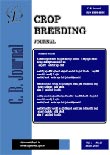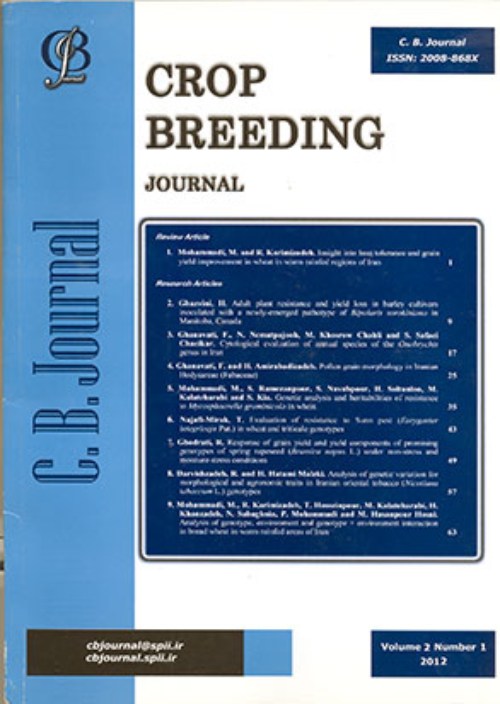فهرست مطالب

Crop Breeding Journal
Volume:4 Issue: 1, Winter-Spring 2014
- تاریخ انتشار: 1393/12/19
- تعداد عناوین: 8
-
-
Pages 1-14Seedling and adult-plant response to stem rust of 103 Iranian and Syrian bread and durum wheat genotypes was investigated using stem rust races TKTTC and TTKSK in seedling tests and TKTTC and TTKST at the adult-plant stage. The same genotypes were characterized with simple sequence repeat (SSR), sequence tagged site (STS) and cleaved amplified polymorphic sequence (CAPS) markers linked to Sr2, Sr22, Sr24, Sr25, Sr26, Sr31, Sr36, Sr39, and Sr46. In seedling tests, three phenotypic groups were identified: those lacking effective resistance genes, those postulated to carry Sr31, and those that were resistant to TKTTC and TTKSK. Adult-plant assessment indicated the presence of adult-plant resistance (APR) to TKTTC and TTKST mainly due to Sr2 and uncharacterized resistance gene(s). Using molecular markers, Sr2 was confirmed as the most common resistance gene detected in Iranian genotypes. It was detected alone in 38 genotypes, in combination with Sr31 in 11 genotypes, and combined with Sr31+Sr25 in one genotype. In total, Sr31 was postulated in 19 genotypes. Among Syrian genotypes, Sr2 was detected alone in one and in combination with Sr31 in two bread wheat cultivars. No diagnostic DNA fragment associated with the markers was present in the durum wheat genotypes. Haplotype analysis of 103 genotypes using Sr2-linked markers csSr2 and STS#Sr2 indicated that csSr2 was a better predictor of the presence of Sr2 gene in wheat.Keywords: adult plant resistance, bread wheat, durum wheat, haplotype analysis, resistance genes
-
Pages 15-21Genetic drift of germplasm in cultivated wheat is good motivation for studying genetic diversity in its wild relatives. In this study, R-RAP, a new retrotransposon-based marker, was applied to assess the structure and genetic diversity of 30 accessions of Aegilops sp. originating from different geographical regions of Iran. The 15 R-RAP primer combinations revealed a total of 338 bands ranging from 16 (LTR1061 – OPA02) to 29 (LTR2116 – OPG06), with an average of 22.5 bands per primer. The size of the amplified bands varied from 100 to 1500bp. The total average of polymorphism information content (PIC) was 0.30. The highest PIC value (0.46) was for primer LTR1061-OPG06. Of the three studied Aegilops species, Ae. tauschii possesses the highest level of genetic diversity. UPGMA cluster separated the three Aegilops species into three discrete groups. Results show that R-RAP markers could be a reliable marker system for organizing genetic variability and detecting useful diversity for wheat breeding purposes. The different diversity parameters calculated in this study demonstrated the high diversity present in Aegilops accessions.Keywords: Aegilops, genetic variability, polymorphism information content (PIC), R, RAP markers
-
Pages 23-33Synthetic hexaploid wheats (SHWs) are an important component of the breeding programs of the International Maize and Wheat Improvement Center (CIMMYT). CIMMYT germplasm is the most important source of genetic resources for wheat breeding programs in Iran, but their utilization has to be examined prior to their incorporation into breeding programs. This study was conducted to evaluate the resistance of 128 CIMMYT SHWs to septoria tritici blotch (STB), a destructive wheat disease caused by Zymoseptoria tritici. Wheat seedlings were inoculated with Z. tritici spores in the greenhouse, kept at 20-22ºC and scored 21 days post inoculation by estimating the percentage of necrotic lesions bearing pycnidia. Inter simple sequence repeat (ISSR) markers revealed that 11 Z. tritici isolates had high genetic variability. The isolates varied in their virulence towards SHWs. Among all interactions (n=1408), 304 resistance responses were identified. Of 128 genotypes, 60 synthetic hexaploid wheat genotypes showed no resistance response, whereas the remaining genotypes showed specific resistance to one or more isolates. Interestingly, nine genotypes were resistant to all isolates tested. Isolate RM46 collected from Khuzestan Province was virulent on 87% of SHWs, suggesting that it has the lowest number of avirulence genes. Isolate RM155 collected from Golestan Province displayed the highest number of incompatible interactions (n=42), indicating that it possesses the highest number of avirulence genes. RM151 was the most aggressive isolate with the highest mean disease severity (69%), whereas RM41 was the least aggressive isolate with the lowest mean disease severity (37%). The present study was the first conducted to evaluate CIMMYT SHWs for resistance to Iranian Z. tritici isolates. Our results showed that some SHWs possess a broad spectrum of resistance gene(s) or a combination of a set of effective genes against various STB isolates.Keywords: avirulent gene, genetic variability, Mycosphaerella graminicola, resistance genes, virulence spectrum
-
Pages 35-45Spot blotch, caused by Cochliobolus sativus, is one of the most damaging foliar diseases of barley around the world. Although chemical control of plant diseases is an effective tool to reduce pathogen damage, the most efficient and environmentally sound means of spot blotch control is through the deployment of resistant cultivars. The aim of this study was to elucidate the genetic basis of spot blotch resistance in barley line TR 251, a Canadian breeding line with a high level of spot blotch resistance. Infection responses induced by C. sativus isolate WRS1938 in 226 doubled haploid lines derived from the cross TR 251 × CDC Bold were analyzed, and DNA samples from the parents and bulks of 11 resistance and 11 susceptible lines were tested using bulked segregant analysis (BSA) with 376 SSR markers and 256 combinations of amplified fragment length polymorphism (AFLP) markers. Identification of the quantitative trait loci (QTL)-linked markers was done using a selective genotyping approach by both binomial distribution and hypergeometric distribution tests. Four putative loci on chromosomes 1H, 3H, 5H, and 7H were found to be associated with spot blotch resistance in line TR 251; of these, the two loci located on chromosomes 1H and 5H had not been reported in previous studies. Both of these loci are likely unique and presumably contribute to the superior C. sativus resistance of line TR 251.Keywords: doubled haploid line, foliar disease, infection response, QTL analysis
-
Pages 47-56Evaluating cultivars in the presence of unpredictable genotype × environment interaction (GEI) is a major problem in crop breeding programs. This study was conducted to: (1) evaluate seed yield stability of 15 safflower genotypes grown in three consecutive seasons (2005-08) at three locations in Iran; and (2) investigate the inter-relationships among eight agronomic traits using the genotype × trait (GT) biplot technique. The additive main effect and multiplicative interaction (AMMI) analysis, the stability parameters derived from the AMMI model, Shukla’s analysis, genotype plus GE (mean performance + stability) distance (GGED), yield-stability (YS) statistic, and several common stability procedures were used to analyze GEI. Results of the AMMI analysis showed that main effects due to genotype (G), environment (E), and GEI, as well as the first six interaction principal component axes (IPCA1 to 6), were significant (P0.01). The partitioning of GEI also revealed that both heterogeneity caused by the environmental index and heterogeneity caused by residual GEI were important sources of variation. According to rank correlation analysis, stability parameters can be categorized into three distinct sections related to static and dynamic concepts of stability. The parameters of the three groups ranked the genotypes in different ways. Genotypes G12, G9, G11 and G8 were superior in terms of both stability and high yield. The GT biplot revealed that seed yield was positively and significantly associated with seed weight and heads per plant, but oil content was not correlated with seed yield.Keywords: AMMI model_genotype plus GE distance_genotype × trait (GT) biplot_stability parameters_yield_stability statistic
-
Pages 57-64To estimate genetic progress and the variation in agronomic characteristics and phenology in 15 bread wheat (Triticum aestivum L.) cultivars released in Iran between 1952 and 2009, a field experiment was conducted at the Seed and Plant Improvement Institute’s Research Field Station in Karaj, Iran, in the 2009-2010 and 2010-2011 growing seasons. Temporal variation trends of the measured traits revealed that grain yield and related traits have increased in more recently released cultivars, though thousand-grain weight has changed only slightly compared with older cultivars released during 1952-2009. Number of days to heading and to anthesis did not change in modern cultivars, but grain-filling period and days to physiological maturity did increase. Grain number spike-1 and rate of grain growth increased but plant height decreased in more recently released cultivars.Keywords: anthesis, grain growth rate, physiological maturity, thousand, grain weight
-
Pages 65-72Genetic diversity of 38 maize hybrids was studied using 12 SSR primers and morphological traits under two different irrigation conditions. The 38 hybrids were evaluated in two trials, one under well-watered (WW) conditions and one under drought-stress (DS) conditions, using an RBCD design with three replications for two years (2008-09) in Moghan, Iran. The total number of PCR-amplified products was 40 bands, all of them polymorphic. Primer Phi031 generated the highest number of bands (6). Among the studied primers, UMC2359, PHI031 and UMC1862 showed the maximum polymorphism information content (PIC) and the greatest diversity. These were the most informative primers and thus could be used to assess the diversity of maize hybrids. To determine the genetic relationship among maize hybrids, cluster analysis was performed based on both morphological traits (using the Ward method) and SSR markers (using the CLINK method). Maize hybrids were divided into three main groups based on SSR markers. Principal coordinate analysis (PCoA) of a similarity matrix of hybrids showed that the first 13 coordinates explained 84.73% of the total variance, whereas the first two coordinates explained only 28.14% of total variance. Cluster analysis of morphological traits divided the maize hybrids into two groups under both WW and DS conditions. Grouping hybrids based on morphological data under WW and DS conditions yielded different groups. Generally, results indicated that SSR markers are able to more efficiently classify closely related maize hybrids than morphological traits.Keywords: drought stress, genetic relationship, molecular markers, simple sequence repeats
-
Pages 73-80Pistacia khinjuk (Stocks) is a native species that, along with P. atlantica, is widely distributed from eastern to western Iran through the Makran Zone, Zagros Mountains and the Sanandaj-Sirjan Zone, ranging from 50 to 3300 m above sea level. The identification of resistance gene analogs holds great promise for developing resistant plants. A PCR approach with degenerate primers designed from conserved nucleotide binding site-leucine rich repeat (NBS-LRR) regions of known disease resistance (R) genes was used to amplify and clone homologous sequences from P. khinjuk. The primers resulted in amplicons with an expected size of 500 bp. The nucleotide sequence of three amplicons was obtained through sequencing; their predicted amino acid sequences compared to each other and to the amino acid sequences of known R-genes revealed significant sequence similarity. Alignment of deduced amino acid sequence of P. khinjuk resistance gene analogs (RGAs) showed strong identity (42-60%) to NBS-LRR proteins R-gene subfamily from other plants. A P-loop motif (GMMGGEGKTT), conserved and hydrophobic motif GLPLAL, kinase-2a motif (LLVLDDV), where it was replaced by IAVFDDI and kinase-3a (FGPGSRIII), were present in all RGAs. A phylogenetic tree based on the deduced amino-acid sequences of PKHRGA1, PKHRGA2, PKHRGA3, and RGAs from different species, indicated that they were separated into two clusters The NBS analogs that we isolated can be used as guidelines to eventually isolate numerous R-genes in pistachio.Keywords: cloning, Pistacia khinjuk, resistance gene analog (RGA)


